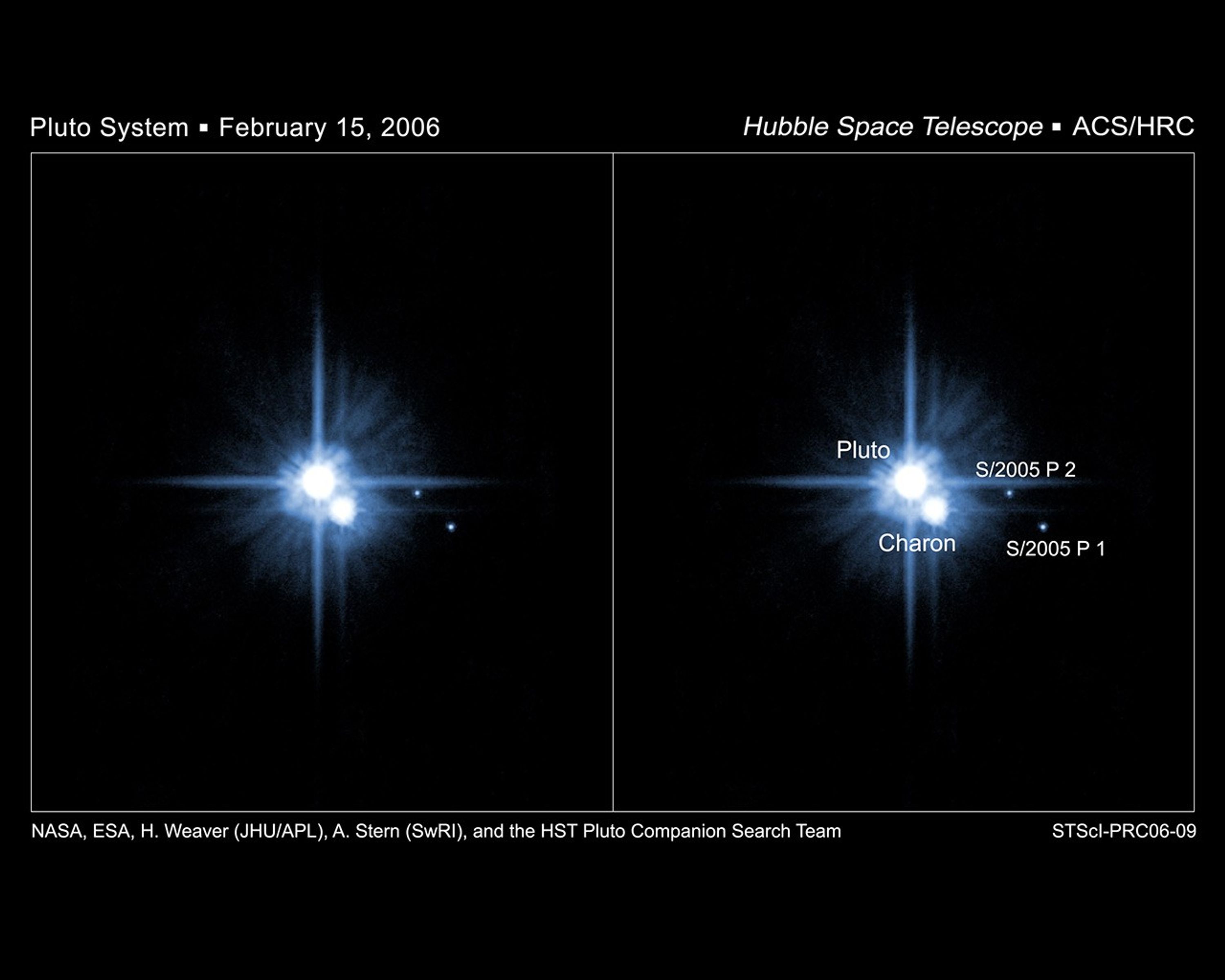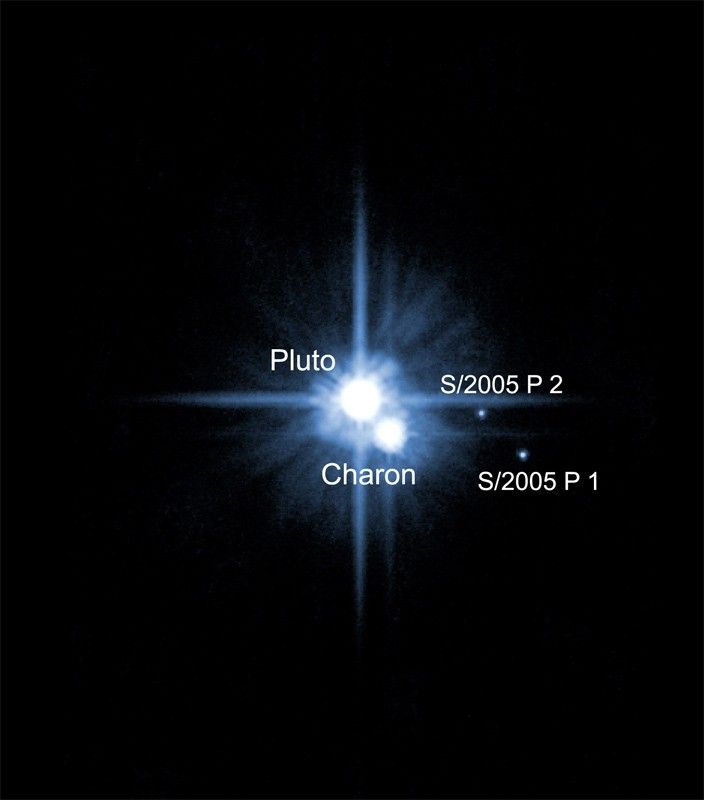1 min read
Hubble Confirms New Moons of Pluto

EMBARGOED UNTIL: 1:00 pm (EST) February 22, 2006
PHOTO NO.: STScI-PRC06-09
HUBBLE CONFIRMS NEW MOONS OF PLUTO
Anxiously awaited follow-up observations with NASA's Hubble Space Telescope have confirmed the presence of two new moons around the distant planet Pluto. The moons were first discovered by Hubble in May 2005, but the science team probed even deeper into the Pluto system last week to look for additional satellites and to characterize the orbits of the moons.
Though the team had little doubt the moons are real, they were happy to see the moons show up very close to the locations predicted from the earlier Hubble observations. The initial discovery is being reported today in this week's edition of the British science journal Nature.
The confirmation reinforces the emerging view that the Kuiper Belt, a swarm of icy bodies encircling the solar system beyond Neptune, may be more complex and dynamic than astronomers once thought. Pluto resides inside the Kuiper Belt and is about 3 billion miles from the Sun. Pluto was discovered in 1930.
The moons' orbits are in the same plane as the orbit of the much larger satellite Charon (discovered in 1978). This likely means the moons were not captured, but instead were born, along with Charon, in what is commonly theorized to have been a titanic collision between two Pluto-sized objects over 4 billion years ago.
A team of astronomers, led by Hal Weaver of the Johns Hopkins University Applied Physics Laboratory in Laurel, Md., and Alan Stern of the Southwest Research Institute in Boulder, Colo., made the new observations on Feb. 15, 2006, with Hubble's Advanced Camera for Surveys (ACS).
The team used the sharp vision of the ACS to do a targeted search of the region around and inside the orbits of the twin moons. In addition to confirming the reality of the new moons, the observations also rule out the possibility of other satellites of roughly similar size orbiting Pluto inside the orbits of the two moons. The moons, provisionally designated S/2005 P 1 and S/2005 P 2, are approximately 40,000 and 30,000 miles away from Pluto, respectively.
Astronomers believe that the formation of the Pluto system is similar to that of our Earth and Moon. In both cases a comparable-sized body slammed into the parent planet. Simulations show that debris from the collision would go into an orbit around the planet and coalesce to form one or more satellites. Investigating how Pluto ended up with three moons while the Earth has only one should yield valuable insights into the processes by which satellite systems form around planets.
The team will use Hubble again on March 2 to study the new moons. They hope the follow-up observations will provide information on the moons' color, as well as their size and shape, which could yield further clues about the formation and evolution of the Pluto system.
In the Hubble image, Pluto is in the center and Charon is just below it. P 1 is to the right and just below Charon. P 2 is to the right of Pluto and Charon.
The Hubble Space Telescope is a project of international cooperation between NASA and the European Space Agency. The Space Telescope Science Institute in Baltimore conducts Hubble science operations. The Institute is operated for NASA by the Association of Universities for Research in Astronomy, Inc., Washington.
About the Object
- DistanceDistanceThe physical distance from Earth to the astronomical object. Distances within our solar system are usually measured in Astronomical Units (AU). Distances between stars are usually measured in light-years. Interstellar distances can also be measured in parsecs.Although its orbit is highly eccentric, Pluto's average distance from the Sun is 39.44 astronomical units (roughly 3.6 billion miles or 5.9 billion kilometers).
- DimensionsDimensionsThe physical size of the object or the apparent angle it subtends on the sky.Pluto has a diameter of roughly 1,416 miles (2,280 kilometers) at the equator.
About the Data
- Data DescriptionData DescriptionProposal: A description of the observations, their scientific justification, and the links to the data available in the science archive.
Science Team: The astronomers who planned the observations and analyzed the data. "PI" refers to the Principal Investigator.These HST data are from proposal 10774: H.A. Weaver (JHU/APL), S.A. Stern and J.R. Spencer (SwRI), M.W. Buie (Lowell Obs.), E. Young, L.A. Young, and A.J. Steffl (SwRI), M. Mutchler (STScI) and W.J. Merline (SwRI). - InstrumentInstrumentThe science instrument used to produce the data.HST>ACS/HRC
- Exposure DatesExposure DatesThe date(s) that the telescope made its observations and the total exposure time.February 15, 2006
- FiltersFiltersThe camera filters that were used in the science observations.F606W (V)
- Object NameObject NameA name or catalog number that astronomers use to identify an astronomical object.Pluto
- Object DescriptionObject DescriptionThe type of astronomical object.Dwarf Planet with Satellites
- Release DateFebruary 22, 2006
- Science ReleaseHubble Confirms New Moons of Pluto
- Credit

This image was originally black and white and recorded only overall brightness. These brightness values were translated into a range of bluish hues. Such color "maps" can be useful in helping to distinguish subtly-varying brightness in an image. The colors in this image are not what human eyes would see looking at Pluto.
Share
Details
Claire Andreoli
NASA’s Goddard Space Flight Center
Greenbelt, Maryland
claire.andreoli@nasa.gov






























